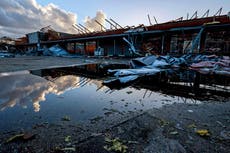Why isn’t it snowing in New York City?
The record was set in 2020 when the city went 332 days without significant flurries
New York City is in its fourth longest stretch without snow, forecasters confirmed on Thursday.
The Big Apple has seen 314 days without measurable snow in Central Park, according to NBC4’s weather team. This ranks 2022-23 in fourth place behind 2002 which went 319 days without snow, and 1972-1973 with 320 days.
The record was set in 2020 when the city went 332 days without significant flurries.
New York City has seen only trace amounts of snow so far this winter – below normal and quite a bit lower than the same time last year, the National Weather Service (NWS) reported. Typically, the Big Apple sees its first snowfall in early December.
The latest that NYC experienced snowfall was January 29, 1973, according to Fox Weather.
Aside from Buffalo, New York and Caribou, Maine which were heavily impacted by the bomb cyclone over the Christmas period, snowfall totals are well below normal across the Eastern United States so far this season, the National Weather Service (NWS) reported this week.
There’s a slight possibility of snow in the city later next week as a series of storm systems will impact the area with the potential for moderate to locally heavy rainfall, NWS reported. However, warm temperatures could be the spanner in the works.
The climate crisis and the current La Nina weather pattern are the main reasons for the lack of snow, meteorologists say.
Rising greenhouse gas emissions, largely from burning fossil fuels, are increasing average global temperatures resulting in myriad consequences including more extreme weather. The past eight years have been the hottest eight on record globally, the United Nations confirmed this week.
Winter is the fastest warming season across much of the US and like everywhere else, New York City will see more severe climate impacts in the coming decades. Among these will likely be decreased snowfall and increased winter rain.
The world is also in its third year of a La Nina, a natural, cyclical cooling of parts of the equatorial Pacific that impacts weather around the world, and the flipside of the warming caused by an El Nino.
The El Nino and La Nina phenomenons are one of the largest natural effects on climate, at times enhancing or masking the human-driven climate crisis.
While New York City remains unseasonably warm, the state has not escaped brutal conditions this winter. In late December, parts of New York state were hit with blizzards and subzero temperatures from the bomb cyclone which swept large parts of the country.
In the Buffalo area, almost 40 people died over the holiday period in the region’s deadliest storm in generations. Thousands of homes were left without power and neighborhoods cut off by more than four feet of snow.
With additional reporting from AP
Join our commenting forum
Join thought-provoking conversations, follow other Independent readers and see their replies
Comments


Bookmark popover
Removed from bookmarks